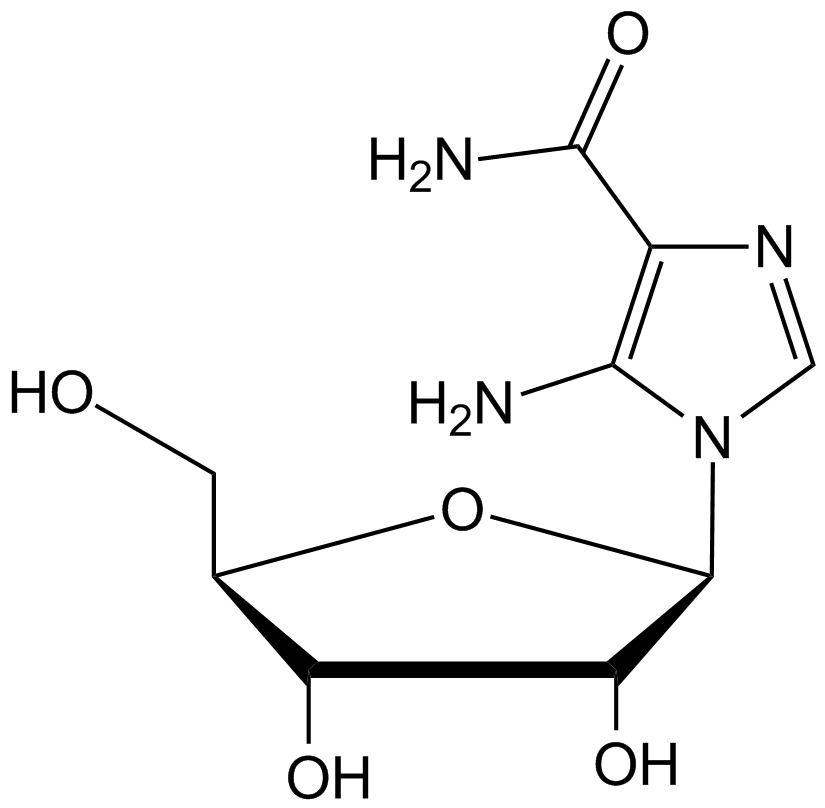AICAR (Synonyms: Acadesine, AICA-Riboside, NSC 105823) |
| Catalog No.GC10518 |
An activator of AMPK
Products are for research use only. Not for human use. We do not sell to patients.

Cas No.: 2627-69-2
Sample solution is provided at 25 µL, 10mM.
AICAR (also called acadesine) is a purine nucleoside. Three pharmacological applications of AICAR were identified: i) stimulation under ischemic conditions of the cardiac production of the vasodilator, adenosine [1]; ii) inhibition of hepatic gluconeogenesis at the level of fructose-1,6-bisphosphatase [2], of therapeutic potential in diabetes; and iii) stimulation of AMP-activated protein kinase (AMPK), initially applied to inhibit the hepatic synthesis of triglycerides and cholesterol [3].
AICAR (treated 48 hours) inhibited cell proliferation of mantle cell lymphoma (MCL) cell lines, REC-1, JEKO-1, UPN-1, JVM-2, MAVER-1 and Z-138, with IC50s of 0.28, 0.59, 0.64, 0.98, 0.50, and 0.14 Mm respectively [4]. AICAR inhibited the growth and depletion of pyrimidine nucleotide pools in fibroblasts [5], accelerated repletion of purine nucleotide pools in heart [6], inhibition of fatty acid, sterol synthesis, and gluconeogenesis in hepatocytes, and increase in glucose uptake in muscle [7].
AICAR (500 mg/kg) injected intraperitoneally into C57BL/6J mice 1 hour before LPS administration. LPS induced the expression of TF mRNA in many major organs, including the lung and liver [8]. A daily administration of 400mg/kg AICAR in mice previously inoculated with a MCL xenotransplant significantly reduced tumor burden when compared to control animals, as soon as 7 days of treatment [9].
References:
[1]. Gruber H E, Hoffer M E, McAllister D R, et al. Increased adenosine concentration in blood from ischemic myocardium by AICA riboside. Effects on flow, granulocytes, and injury[J]. Circulation, 1989, 80(5): 1400-1411.
[2]. Vincent M F, Marangos P J, Gruber H E, et al. Inhibition by AICA riboside of gluconeogenesis in isolated rat hepatocytes[J]. Diabetes, 1991, 40(10): 1259-1266.
[3]. Hardie D G, Carling D, Carlson M. The AMP-activated/SNF1 protein kinase subfamily: metabolic sensors of the eukaryotic cell?[J]. Annual review of biochemistry, 1998, 67: 821.
[4]. Montraveta A, Xargay-Torrent S, López-Guerra M, et al. Synergistic anti-tumor activity of acadesine (AICAR) in combination with the anti-CD20 monoclonal antibody rituximab in in vivo and in vitro models of mantle cell lymphoma[J]. Oncotarget, 2014, 5(3): 726.
[5]. Sabina R L, Patterson D, Holmes E W. 5-Amino-4-imidazolecarboxamide riboside (Z-riboside) metabolism in eukaryotic cells[J]. Journal of Biological Chemistry, 1985, 260(10): 6107-6114.
[6]. Swain J L, Hines J J, Sabina R L, et al. Accelerated repletion of ATP and GTP pools in postischemic canine myocardium using a precursor of purine de novo synthesis[J]. Circulation Research, 1982, 51(1): 102-105.
[7]. Hardie D G, Carling D, Carlson M. The AMP-activated/SNF1 protein kinase subfamily: metabolic sensors of the eukaryotic cell?[J]. Annual review of biochemistry, 1998, 67: 821.
[8]. Zhang W, Wang J, Wang H, et al. Acadesine inhibits tissue factor induction and thrombus formation by activating the phosphoinositide 3-kinase/Akt signaling pathway[J]. Arteriosclerosis, thrombosis, and vascular biology, 2010, 30(5): 1000-1006.
[9]. Montraveta A, de Fri?as M, Campa?s C, et al. The Nucleoside Analogue Acadesine Exerts Antitumoral Activity and Cooperates with Conventional Agents In In Vitro and In Vivo Models of Mantle Cell Lymphoma[J]. Blood, 2010, 116(21): 3918.
Average Rating: 5 (Based on Reviews and 30 reference(s) in Google Scholar.)
GLPBIO products are for RESEARCH USE ONLY. Please make sure your review or question is research based.
Required fields are marked with *




















